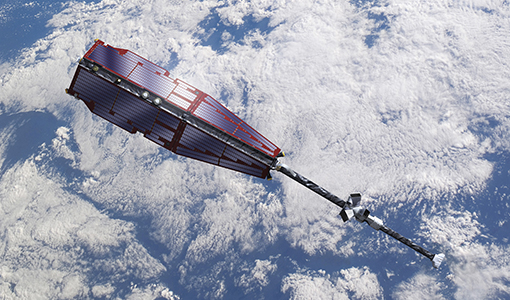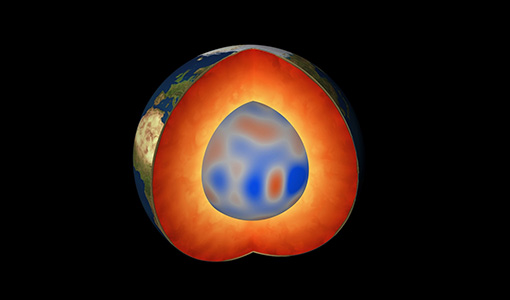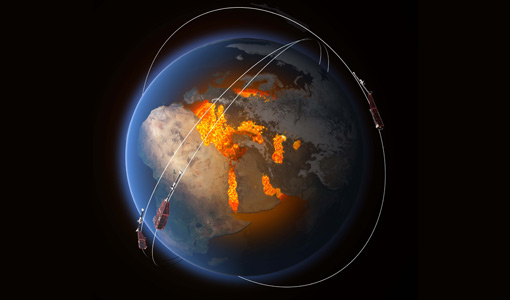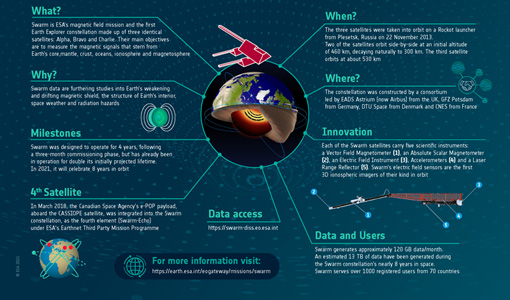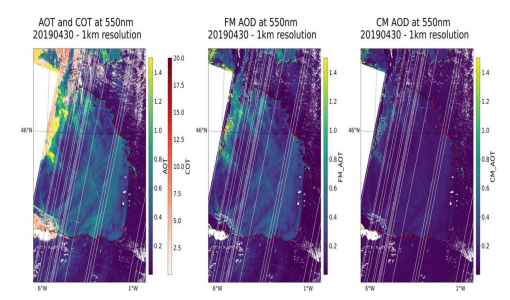- All Categories (262)
- Data (1)
- News (44)
- Missions (3)
- Events (10)
- Tools (3)
- Activities (11)
- Documents (190)
Event - Meeting
VH-RODA and CEOS SAR workshop
The workshop provided an open forum for the presentation and discussion of current status and future developments related to the calibration and validation of space borne very high-resolution SAR and optical sensors and data products.
News - Operational News
Update on Swarm Field-Aligned Current Dual (FAC_AC) data missing from 7 November 2021
As a follow-up of the news published on 23 November 2021, we want to update Swarm users about the missing Field-Aligned Current Dual (FAC_TMS_2F) data since 7 November 2021.
News - Operational News
Update on Swarm Field-Aligned Current Dual (FAC_AC) data issue
As a follow-up of the news published on 23 November 2021 and on 16 December 2021, we want to update Swarm users about the issue affecting Field-Aligned Current Dual (FAC_TMS_2F) data.
News - Success Stories
Ten years of Swarm data help reveal processes in Earth’s core
The tenth birthday of ESA’s three-satellite Swarm constellation has been a game changer for research into Earth’s magnetic field and core dynamics, as set out by an ESA-funded project.
Activity - Projects
SWESMAG
The project SWESMAG relies on magnetic field data from Swarm to investigate Space Weather (SWE) effects related to Geomagnetic Induced Currents (GICs), driven mainly by rapid variations of the ionospheric Polar Electrojet (PEJ) currents and quantified (loosely) by the variation of the horizontal ground magnetic field component dH/dt.
News - Success Stories
Swarm’s orbital dance: counter-rotating and closer, for the benefit of science
Since variations in Earth’s magnetic field directly reflect the flow of fluid in the outermost core, new information from Swarm will further our understanding of the physics and dynamics of Earth's stormy heart—and the satellites are recently flying in a counter-rotating phase and closer in their separation, to enable scientists to discover new elements.
Activity - Projects
Swarm-SWITCH
Space weather in the thermosphere-ionosphere can have a variety of adverse effects on technological systems, for example by affecting radio signals and satellite orbits.
Tools - Other
Swarm-Aurora
Swarm-Aurora, a web-based tool, was designed to facilitate and drive the use of Swarm in-situ measurements in auroral science.
News - Success Stories
Swarm unveils magnetic waves deep down
Using information from ESA’s Swarm satellite mission, scientists have discovered a completely new type of magnetic wave that sweeps across the outermost part of Earth’s outer core every seven years.
Mission - Earth Explorers
Swarm Product Data Handbook
The Swarm Product Data Handbook provides a detailed description of Level 1b and Level 2 products derived from Swarm data.
News - Operational News
Swarm Field-Aligned Current Dual (FAC_AC) data unavailable from 4 May 2022
Due to the recent orbit raise manoeuvres which changed the orbital configuration of Swarm Alpha and Charlie, no Field-Aligned Current Dual (FAC_TMS_2F) data are being produced since 4 May 2022.
Activity - Projects
Swarm DISC pre-study 5.1
Understanding the complex dynamics of neutral winds in the upper atmosphere is crucial for understanding thermosphere-ionosphere interactions. However, the limited availability of measurements and data coverage has hindered the comprehensive characterization of these winds.
News - Success Stories
Swarm data help estimate the impact of space weather
Energy from space weather mostly deposits itself as heat in the upper atmosphere, posing risks to satellites orbiting in the same altitude.
News - Operational News
Swarm Alpha and Charlie orbit raise campaign starting on 3 May 2022 - Potential impact on data quality
After more than eight years of operations, the Swarm constellation is continuing to provide multi-point measurements of the Earth’s magnetic field and ionospheric parameters with unprecedented accuracy.
News - Infographics
Swarm - ESA's magnetic field satellite mission
Learn more about ESA's Swarm mission, an Earth Explorer dedicated to studying Earth's magnetic field, in our latest infographic.
Mission - Earth Explorers
Swarm
Swarm is dedicated to creating a highly detailed survey of Earth’s geomagnetic field and its temporal evolution as well as the electric field in the atmosphere using a constellation of three identical satellites.
Document - General Reference
Sterckx-Sindy-ICOS-2017.pdf
Poster presentation at IOCS (International Ocean Colour Science) 2017, 5 -19 May 2017, Lisbon, Portugal.
News - Success Stories
Ship trails in the Bay of Biscay observed using PROBA-V imagery
Ship trails have been perceived as convincing evidence of aerosol-cloud interaction. Ship emissions have been proven to contribute by about 1.9% and 2.9% to the increase in the global total and fine-mode aerosol optical thickness (AOT) respectively over a five year period (Peters et al. 20212).
